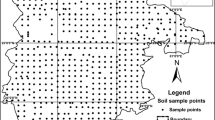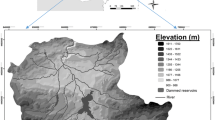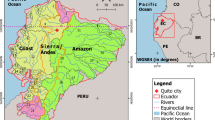Abstract
Land degradation by soil erosion is one of the most serious problems and environmental issues in many ecosystems of arid and semi-arid regions. Especially, the disturbed areas have greater soil detachability and transportability capacity. Evaluation of land degradation in terms of soil erodibility, by using geostatistical modeling, is vital to protect and reclaim susceptible areas. Soil erodibility, described as the ability of soils to resist erosion, can be measured either directly under natural or simulated rainfall conditions, or indirectly estimated by empirical regression models. This study compares three empirical equations used to determine the soil erodibility factor of revised universal soil loss equation prediction technology based on their geospatial performances in the semi-arid catchment of the Saraykoy II Irrigation Dam located in Cankiri, Turkey. A total of 311 geo-referenced soil samples were collected with irregular intervals from the top soil layer (0–10 cm). Geostatistical analysis was performed with the point values of each equation to determine its spatial pattern. Results showed that equations that used soil organic matter in combination with the soil particle size better agreed with the variations in land use and topography of the catchment than the one using only the particle size distribution. It is recommended that the equations which dynamically integrate soil intrinsic properties with land use, topography, and its influences on the local microclimates, could be successfully used to geospatially determine sites highly susceptible to water erosion, and therefore, to select the agricultural and bio-engineering control measures needed.
Similar content being viewed by others
References
Anonymous (1988). Çankırı-E16 paftası 1/100000 ölçekli açınsama nitelikli Türkiye jeoloji haritaları serisi. Maden Teknik Arama Genel Müdürlüðü, Ankara (in Turkish).
Bartsch, K. P., Van Miegroet, H., Boettinger, J., & Dobrwolski, J. P. (2002). Using empirical erosion models and GIS to determine erosion risk at Camp Williams. Journal of Soil and Water Conservation, 57, 29–37.
Basaran, M., Erpul, G., & Ozcan, A. U. (2008). Variation of macro-aggregate stability and organic matter fractions in the basin of Saraykoy II Irrigation Dam, Cankiri, Turkey. Fresenius Environmental Bulletin, 17, 224–239.
Basaran, M., Erpul, G., Tercan, A. E., & Canga, M. (2007). The effects of land use changes on some soil properties in Indağı Mountain Pass—Çankırı, Turkey. Environmental Monitoring and Assessment, 136, 101–119.
Baskan, O., & Dengiz, O. (2008). Comparison of traditional and geostatistical methods to estimate soil erodibility factor. Arid Land Research and Management, 22(1), 29–45.
Bayramin, I., Basaran, M., Erpul, G., & Canga, M. R. (2008). Assessing the effects of land use changes on soil sensitivity to erosion in a highland ecosystem of semi-arid Turkey. Environmental Monitoring and Assessment, 140, 249–265.
Burgess, T. M., & Webster, R. (1980a). Optimal interpolation and isarithm mapping of soil properties: I. The semivariogram and punctual kriging. Journal of Soil Science, 31(3), 315–331.
Burgess, T. M., & Webster, R. (1980b). Optimal interpolation and isarithm mapping of soil properties: II. Block kriging. Journal of Soil Science, 31(3), 333–344.
Burke, E. J., Brown, S. J., & Christidis, N. (2006). Modeling the recent evolution of global drought and projections for the twenty-first century with the Hadley Centre climate model. Journal of Hydrometeorology, 7(5), 1113–1125.
Burrough, P. A. (1987). Principles of geographical information systems for land resources assessment (pp. 147–165). Oxford: Clarendon.
Campbell, J. B. (1978). Spatial variation of sand content and pH within single contiguous delineations of two soil mapping units. Soil Science Society of American Journal, 42, 460–464.
Castrignano, A., Buttafuoco, G., Canu, A., Zucca, C., & Madrau, S. (2008). Modeling spatial uncertainty of soil erodibility factor using joint stochastic simulation. Land Degradation and Development, 19(2), 198–213.
Cerri, C. E. P., Dematte, J. A. M., Ballester, M. V. R., Martinelli, L. A., et al. (2001). GIS erosion risk assessment of the Piracicaba River Basin, southeastern Brazil. Mapping Sciences and Remote Sensing, 38, 157–171.
Chien, Y. J., Lee, D. Y., Guo, H. Y., & Houng, K. H. (1997). Geostatistical analysis of soil properties of mid-west Taiwan Soils. Soil Science, 162(4), 291–297.
Dahlgren, A. R., Bottinger, L. T., Huntington, L. G., & Amundson, A. R. (1997). Soil development along an elevation transect in the western Sierra Nevada, California. Geoderma, 78, 207–236.
Di, H. J., Trangmar, B. B., & Kemp, R. A. (1989). Use of geostatistics in designing sampling strategies for soil survey. Soil Science Society of America Journal, 53(4), 1163–1167.
Dregne, H. E., & Chou, N. T. (1992). Global desertification dimensions and costs, in degradation and restoration of arid lands. Lubbock: Texas Tech University.
Erdogan, E. H., Erpul, G., & Bayramin, I. (2007). Use of USLE/GIS methodology for predicting soil loss in a semi-arid agricultural watershed. Environmental Monitoring and Assessment, 131, 153–161.
Fu, B. J. W. W., Zhao, L. D., Chen, Q. J., Zhang, Y. H., Lu, H., Gulinck, H., et al. (2005). Assessment of soil erosion at large watershed scale using RUSLE and GIS: A case study in the Loess Plateau of China. Land Degradation and Development, 16(1), 73–85.
GDPS (General Directorate of Rural Service) (1986). 1/25000 soil map of Ankara, Turkey. Turkey: Digital Soil Database: Soil and Water Resources National Information Centre.
Goovaerts, P. (1999). Geostatistics in soil science: State-of-the-art and perspectives. Geoderma, 89(1), 1–45.
Held, I. M., Delworth, T. M., Lu, J., Findell, K. L., & Knutson, T. R. (2005). Simulation of Sahel Drought in the 20th and 21st centuries. Proceedings of the National Academy of Sciences, 102(50), 17891–17896.
Hillel, D. (1980). Applications of soil physic (p. 380). New York: Academic.
Isaaks, E. H., & Srivastava, R. M. (1989). An introduction to applied geostatistics (p. 561). New York: Oxford University Press.
Journel, A. G., & Huijbregts, C. S. (1978). Mining geostatistics (p. 600). New York: Academic.
Kinnell, P. I. A. (2001). Slope length factor for applying the USLE-M to erosion in grid cells. Soil and Tillage Research, 58, 11–17.
Kitanidis, P. K. (1997). Introduction to geostatistics: Applications to hydrogeology (p. 274). Cambridge: Cambridge University Press.
Klute, A., & Dirksen, C. (1986). Hydraulic conductivity and diffusivity: Laboratory methods. In A. Klute (Ed.), Methods of soil analysis, part 1: Physical and mineralogical methods (2nd ed., pp. 687–734). Madison: American Society of Agronomy.
Lu, D. L. G., Valladares, G. S., & Batistella, M. (2004). Mapping soil erosion risk in Rondonia, Brazilian Amazonia: Using RUSLE, remote sensing and GIS. Land Degradation and Development, 15, 499–512.
Ma, J. W., Xue, Y., Ma, C. F., & Wang, Z. G. (2003). A data fusion approach for soil erosion monitoring in the Upper Yangtze River Basin of China based on universal soil loss equation (USLE) model. International Journal of Remote Sensing, 24, 4777–4789.
Martin, A., Gunter, J., & Regens, J. (2003). Estimating erosion in a riverine watershed, Bayou Liberty—Tchefuncta River in Louisiana. Environmental Science and Pollution Research, 10(4), 245–250.
Matheron, G. (1963). Principles of geostatistics. Economic Geology, 58(8), 1246–1266.
MEA (Millennium Ecosystem Assessment) (2005). Ecosystems and human well-being: Desertification synthesis. Washington: World Resource Institute.
Millward, A. A., & Mersey, J. E. (1999). Adapting the RUSLE to model soil erosion potential in a mountainous tropical watershed. Catena, 38, 109–129.
Nelson, D. W., & Sommers, L. E. (1982). Total Carbon, organic carbon, and organic matter. In A. L. Page (Ed.), Methods of soil analysis. Part 2 (2nd ed., pp. 539–579). Madison: American Society of Agronomy.
Oldeman, L. R. (1994). The global extent of land degradation. In D. J. Greenland & I. Szabolcs (Eds.), Land resilience and sustainable land use (pp. 99–118). Wallingford: CABI.
Ouyang, D., & Bartholic, J. (2001). Web-based GIS application for soil erosion prediction. In Proceedings of an international symposium—soil erosion research for the 21st century (pp. 260–263). Honolulu, HI.
Ozcan, A. U., Erpul, G., Basaran, M., & Erdogan, H. E. (2008). Use of USLE/GIS technology integrated with geostatistics to assess soil erosion risk in different land uses of Indagi Mountain Pass—Cankırı, Turkey. Environmental Geology, 53(8), 1731–1741.
Parysow, P., Wang, G., Gerther, G., & Anderson, A. (2003). Spatial uncertainty analysis for mapping soil erodibility based on joint sequential simulation. Catena, 53, 65–78.
Perez-Rodriquez, R., Marques, M. J., & Bienes, R. (2007). Spatial variability of the soil erodibility parameters and their relation with the soil map at subgroup level. Science of the Total Environment, 378, 166–173.
Ravi, S., Breshears, D. D., Huxman, T. E., & D’Odoric, P. (2009). Land degradation in drylands: Interactions among hydrologic-aeolian erosion and vegetation dynamics. Geomorphology. doi:10.1016/j.geomorph.2009.11.023.
Renard, K. G., Foster, G. R., Weesies, G. A., McCool, D. K., & Yoder, D. C. (1997). Predicting soil erosion by water: A guide to conservation planning with the revised universal soil loss equation RUSLE (p. 404). U. S. Department of Agriculture, Agriculture Handbook 703, Government Printing Office, SSOP, Washington, D.C., ISBN 0-16-048938-5.
Romkens, M. J. M., Prasad, S. N., & Poesen, J. W. A. (1986). Soil erodibility and properties. In Proc. 13th congree. international soil science society (Vol. 5, pp. 492–504). Germany: Hamburg.
Seager, R., Ting, M., Held, M. I., Kushnir, Y., Lu, J., Vecchi, G., et al. (2007). Model projections of an imminent transition to a more arid climate in southwestern North America. Science, 316, 1181–1184.
Shirazi, M. A., & Boersma, L. (1984). A unifying quantitative analysis of soil texture. Soil Science Society America of Journal, 48, 142–147.
Smith, R. L., & Smith, T. M. (2000). Elements of ecology (4th ed.). San Francisco: Addison Wesley Longman.
Soil Survey Staff (1996). Soil survey laboratory methods manual (No. 42, Version 3.0). Soil Survey Investigations Reports. Lincoln: USDA-NRCS.
Tang, Y. B. (2002). Comparison of semivariogram models for Kriging monthly rainfall in eastern China. Journal of Zhejiang University Science, 3(5), 584–590.
Torri, D., Poesen, J., & Borselli, L. (1997). Predictability and uncertainty of the soil erodibility factor using a global dataset. Catena, 31, 1–22.
Torri, D., Poesen, J., & Borselli, L. (2002). Corrigendum to “Predictability and uncertainty of the soil erodibility factor using a global dataset” [Catena 31 (1997) 1–22] and to “Erratum to Predictability and uncertainty of the soil erodibility factor using a global dataset. [Catena 32 (1998) 307–308]”. Catena, 46, 309–310.
Trangmar, B. B., Yost, R. S., & Uehara, G. (1985). Application of geostatistics to spatial studies of soil properties. Advances in Agronomy, 38, 45–94.
Tsui, C. C., Chen, Z. S., & Hsieh, C. F. (2004). Relationships between soil properties and slope positioning a low land rain forest of southern Taiwan. Geoderma, 123, 131–142.
UNCCD (1994). Elaboration of an international convention to combat desertification in countries experiencing serious drought and/ or desertification, particularly in Africa. U.N. Doc.A/AC.241/27, 33 I.L.M. 1328.
Ventura, S. J., Chrisman, N. R., Conncrs, K., Gurda, R. F., & Martin, R. W. (1988). A land information system for soil erosion control planning. Journal of Soil and Water Conservation, 43(3), 230–233.
Wang, G., Gertner, G., Fang, S., & Anderson, A. B. (2003). Mapping multiple variables for predicting soil loss by geostatistical methods with TM images and a slope map. Photogrammetric Engineering and Remote Sensing, 69, 889–898.
Wang, G., Gertner, G., Liu, X., & Anderson, A. (2001). Uncertainty assessment of soil erodibility factor for revised universal soil loss equation. Catena, 46, 1–14.
Wischmeier, W. H., & Smith, D. D. (1978). Predicting rainfall erosion losses (No. 537). USDA Agricultural Service Handbook. Washington, D.C.
Wischmeier, W. H., Johnson, C. B., & Cross, B. V. (1971). A soil erodibility nomograph for farmland and construction sites. Journal of Soil and Water Conservation, 26, 189–193.
Author information
Authors and Affiliations
Corresponding author
Rights and permissions
About this article
Cite this article
Saygın, S.D., Basaran, M., Ozcan, A.U. et al. Land degradation assessment by geo-spatially modeling different soil erodibility equations in a semi-arid catchment. Environ Monit Assess 180, 201–215 (2011). https://doi.org/10.1007/s10661-010-1782-z
Received:
Accepted:
Published:
Issue Date:
DOI: https://doi.org/10.1007/s10661-010-1782-z




